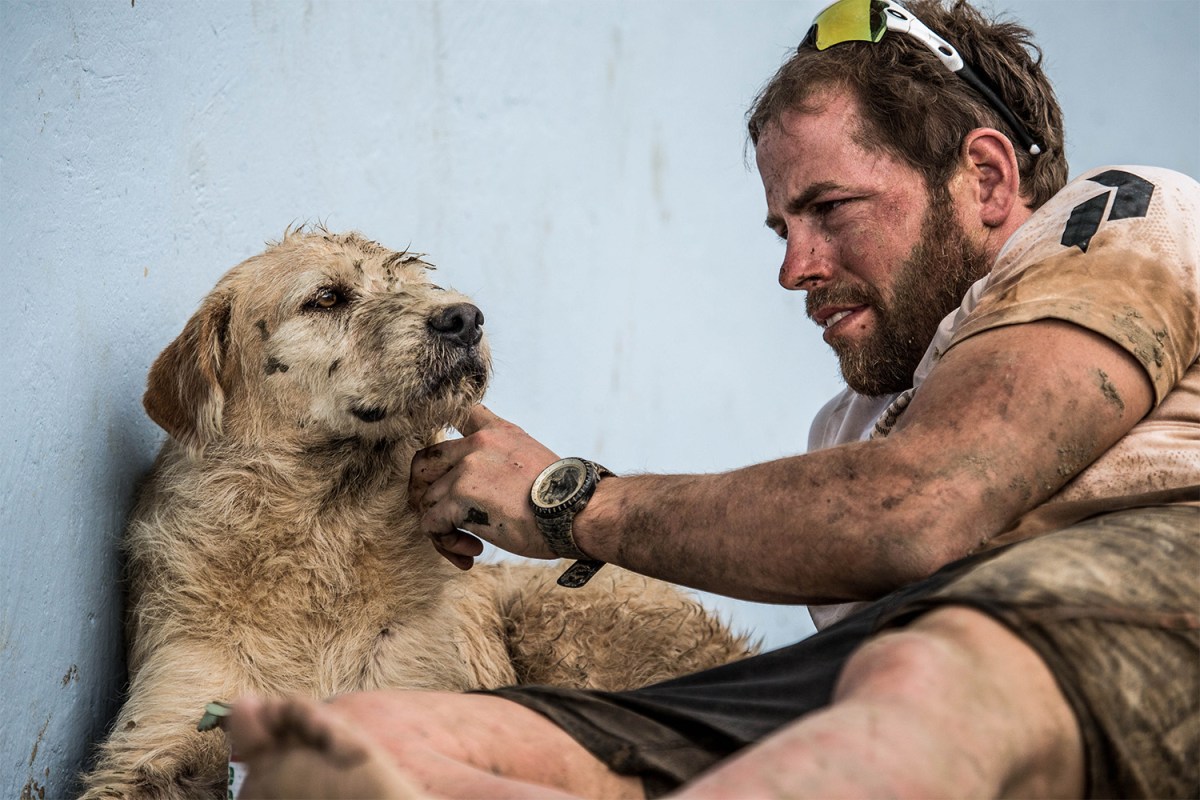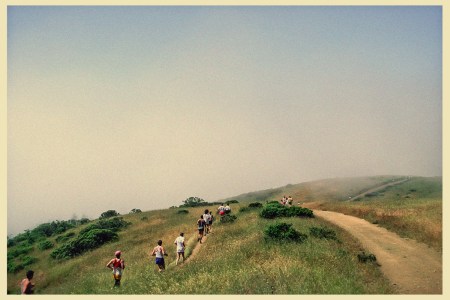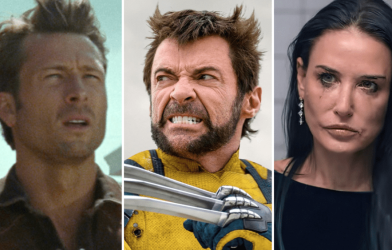Mikael Lindnord is an adventure racer who competed in the world of endurance sports for nearly two decades. Beginning his career in 1997, he was part of the first Swedish team to win an international Adventure Racing World Series event, when he took the podium at Costa Rica 2010.
During the last year of his career, he served as captain for Team Peak Performance and competed with them at the 2014 Adventure Racing World Championship. It was during this race that Lindnord’s life would change forever…after he stumbled into an unlikely friendship with a stray dog along the trail.
InsideHook contributor Charles Thorp spoke with Lindnord about this incredible true story, which is the inspiration for the new Lionsgate movie Arthur the King, starring Mark Wahlberg.
I had been racing for almost 20 years, two decades of my life, by the time the team and I arrived for the 2014 Adventure Racing World Championship. For my entire career I had chased the goal of being a world champion and the ranking of number one in the world. At the time of the race, I was ranked sixth in the world. I was optimistic when we started this race though, considering we had a good team and good partnership support. I was ready to put everything on the line to win.
Everyone dreams about having a perfect race, but anyone in adventure racing knows that it never goes down like that. I guess that’s part of the fun, then, getting thrown these constant problems that you have to solve. For the most part, you hope that you don’t get thrown too many of those problems when you’re competing for the world championship. Of course, for us, that’s how it was going to go.
A Rocky Start in Ecuador
Our team landed in Ecuador around the 31st of October, and two weeks later the race kicked off. From the very beginning, the race was not the start that we had hoped for. There was some bad navigation and we started to fall behind as a consequence. We lost a lot of time. But the thing about adventure racing is you always have time, because you’re running for days and not just hours — you never give up. You never know what’s going on with other teams, or if you’re going to find another way to the finish quicker than the others.
Four days later, we were still in the race and we had a real chance to get into the top three. We finally arrived at this small village, which was the second-to-last transition area. This was the part of the race where we were on our bikes. There was eight hours of sleeping time for that part and we used the last two hours before heading out. I woke up and started to get my bag ready for the next phase, which was a really intense section of jungle — so intense that we were allowed a GPS, which isn’t usually the case, but conventional maps would not be helpful.
I was going over my gear pretty thoroughly and getting some last-minute food as well. There are these Swedish meatballs that the Swedish special forces teams use. I think most people have heard about Swedish meatballs at this point, and these are ones that you can cook on the trail in a warming pack. Once you’ve been on the road for four days, these meatballs are like fine dining. I was enjoying them while looking over my bike and suddenly I started to get the feeling that I was being watched.
Here Comes Arthur
I turned my head slowly to the left and I saw this dog standing there looking at me. My first reaction was wanting to keep the dog away from me, in case he was dangerous, because he didn’t look like he was in a good state. He looked like he had all of the diseases in the world. It looked like nobody had been nice to him his entire life. I couldn’t help but feel a little sorry for him as well, so I gave him a few meatballs.
We were under pressure to get back on the road quickly, as the other Swedish team had headed out about 10 minutes before, so we were hoping to catch up with them. I didn’t really have time to think about him much after that. The jungle was rough during the day and even worse at night. We had to put our headlamps on to see in front of us. But in adventure racing you are also always looking behind you, because you are worried about other teams catching up.
I was checking behind us in the jungle, and when I looked back I didn’t see a team — I could see what looked like a dog. I could just make out the gleam of his eyes from the light of my headlamp. But to be honest, at that moment I had no idea it was the same dog that I had fed the meatballs to earlier. I eventually confirmed it was that same dog when we stopped to change batteries and socks. I was shocked that he had kept up with us all of these hours in his state, and I knew that if he was going to keep following, he had a long journey ahead of him.
It looked like nobody had been nice to him his entire life.
MIKEAL LINDNORD, ON THE MOMENT HE MET ARTHUR
Stray dogs being around us during these races is not entirely uncommon, especially in countries where there are a lot of homeless animals. This is usually when you’re going through towns or village though, and maybe not as regular when you’re going through the jungle. I figured that eventually he would turn around, once he got too far from the places he was familiar with or when he just got tired, especially because he was wounded and looked pretty skinny for his size. But this dog was different than any dog I had come across. I was intrigued by him, so I started to speak to him. I would ask, “Are you sure you still want to keep going?” There he would stay, following us still. At some point during the night we started calling him Arthur.
Then, along the way we started to have issues with the GPS. You couldn’t zoom it too much because it can get confusing to read which way you’re going. Because of this, we ended up going totally the wrong way. We ended up doing an even longer trip through the jungle, and it led to this super close call where we almost went over a cliff. It was pitch dark and suddenly I just felt a strong breeze on my face. We stopped just in time to look down and see treetops. We were right on the edge.
Teammate #5
But there was Arthur, with us all the while, suffering and coming close to disaster. During this time he became less like a random animal and more like a fifth teammate for us. Luckily, we were able to double back and find the trail again. We made it down to where we were supposed to be. I wish I could explain the jungle in the mornings; it’s like the movie Avatar. Everyone was trying to replenish and get ready to go again. I asked around if anyone had anything at all to eat because I was starving, but all I had was a bar and some candy.
One of the guys pulled out two packages of those Swedish meatballs, and in my eyes he was a hero. I took a bite when it was ready — it usually took about 10 minutes with the little heating pack inside. I ate for a bit and my teammate did as well, but we also wanted to share some with Arthur. It was important to us because as much as we were suffering, we knew he must be too. He was laying down next to us, looking pretty exhausted. We were eating this whole time, even if it was not a lot, but he hadn’t been eating anything. So we placed some of the meatballs on this big leaf and pushed it in his direction.
People have asked me why we shared our food, because we were competing in the world championship and it’s not like we had tons to spare. Why are we giving up our limited resources while at the same time trying to podium? But adventure racers understand that often you have people join your journey for a while. It could be someone from another team, or just local people who are going the same way to their source of water, so there is this camaraderie built through common direction that happens.
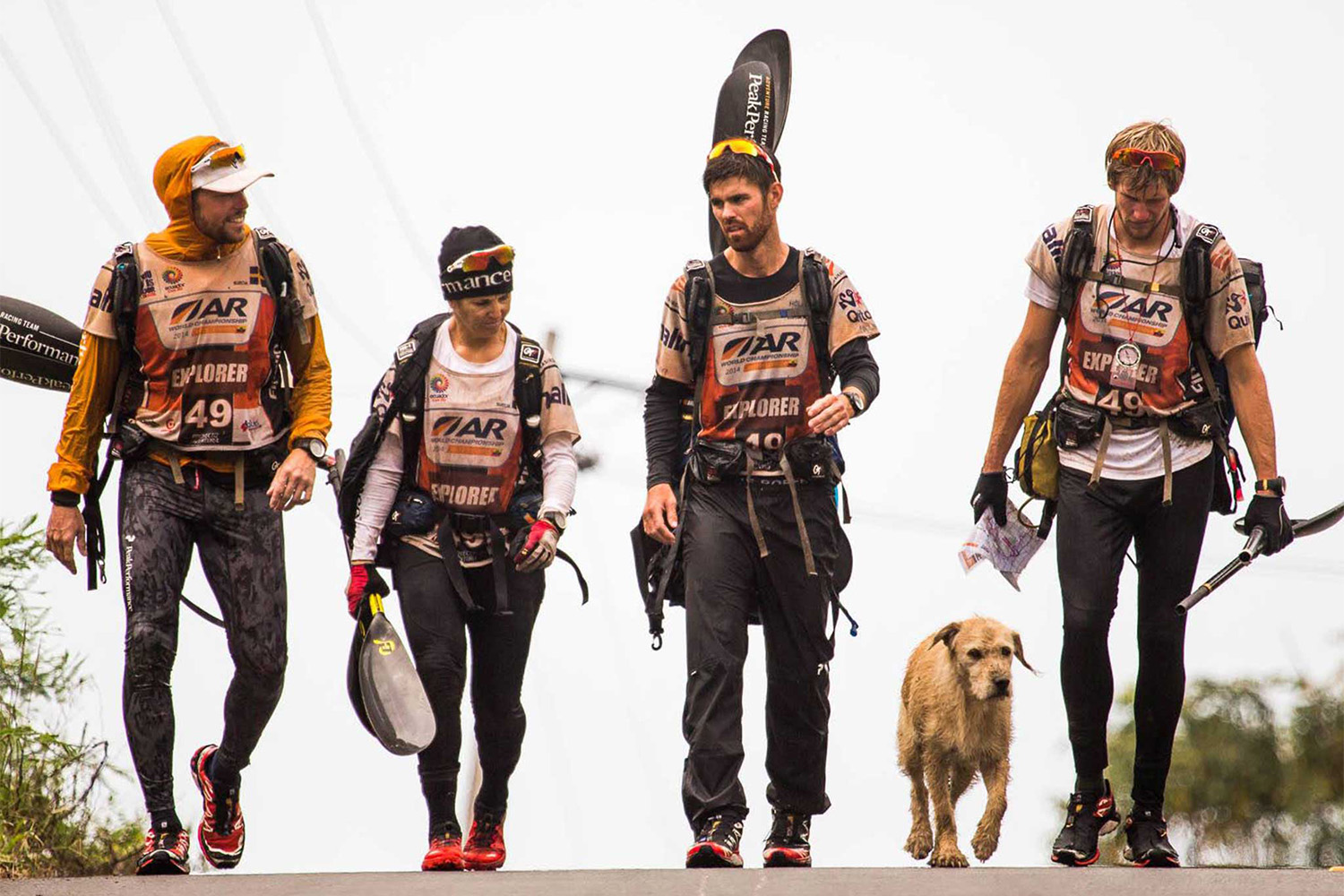
Lindnord says that it was Arthur’s choice to join their adventure racing ream. “That’s another thing about teammates,” he writes. “They have to want to be there, with every fiber of their being.”
Courtesy of Mikael Lindnord
We were all really in shambles when we made it to the final transition area. One of our teammates needed an IV because they were so dehydrated. The next portion of the race meant hopping into a kayak and going down the river. As we were getting ready, I turned to Arthur and said, “This is kind of a point of no return, what are you going to do? Are you going to come with us?” That’s when the race organizers came to us and said that we couldn’t take Arthur in the kayak with us. They said it was too dangerous to have an animal in with us when we were going through these mangroves and rapids — not to mention the world championship is a big race in our world. I understood why they didn’t want to allow it.
So once we got the green light with the water conditions, we started to paddle out. I think we were about 20 meters out when I heard this big splash. I turned around and there was Arthur trying to catch up with us in the water, and he wasn’t the best swimmer. He just had his head above the water, paddling as fast as he could. How could I just leave him there in the water as he was trying so hard to follow us? I asked my teammate to stop and I picked him up out of the river. I didn’t really care about the consequences at that point.
I held him in my lap as we kept paddling. This was the first time I was really close to him and I could really see his wounds and smell him. Even though I felt this connection with him — we all did — it’s not like I knew what I was getting into when I picked him up. I didn’t know if he was going to bark at me or even bite me. Of course, now, in hindsight, I’m so glad that I did it and it seems like it was an easy choice. But really, there were a lot of sane reasons to not have picked him up.
The Most Unpredictable Sport in the World
For people who do adventure racing, it’s high risk. It’s always high risk. Once you’ve experienced this enough, you’re kind of prepared for anything and everything. That was my thinking when I decided to pick him up, and give him a chance — even with the stress of being in a highly competitive race, and perhaps him even capsizing us. He started to freeze a little bit, so I took my jacket and put it over him.
We kept paddling all day. Once the sun came back up, so did Arthur, and eventually he got warm enough to jump back in the water. He saw some fish that he wanted to catch, which meant we had to grab him and get him back in the kayak. We were almost to the finish line when we saw this little waterside village. Arthur jumped out of the kayak again to go into the town there. As we were paddling around the village I thought, Well, I guess this is where he’s getting out.
That’s when I saw Arthur come running out from behind the last little shack of the village in our view and he jumped off of the beach into the river to swim after us. He made it to beside our kayak and just looked up at me as if to say, “Okay, time to pick me up again.” I did and we were on our way again, with our full team.
During these races you never know what’s going to happen. You just do your best to conquer as much of the distance as possible with your team. And that’s what we were doing. The decision for Arthur to join us was his the whole time. That’s another thing about teammates, they have to want to be there, with every fiber of their being. We couldn’t have been the only people who gave him food, or the only way that he had gotten food, because he had lived quite a few years. The team never really sat down and discussed Arthur or what our plan was with him.
That changed when we crossed the finish line. The race was over, but Arthur, our new teammate, still needed help. He needed to see a veterinarian. He needed to eat more. Once we started that process of getting him help is when the Ecuadorian team said that I should adopt him. So that’s when I started the process of finding out if that was going to even be possible. I started by calling [people in Sweden] and talking to people in Ecuador. Basically what I found out was, yes, it’s possible, as long as you have this laundry list of things done.
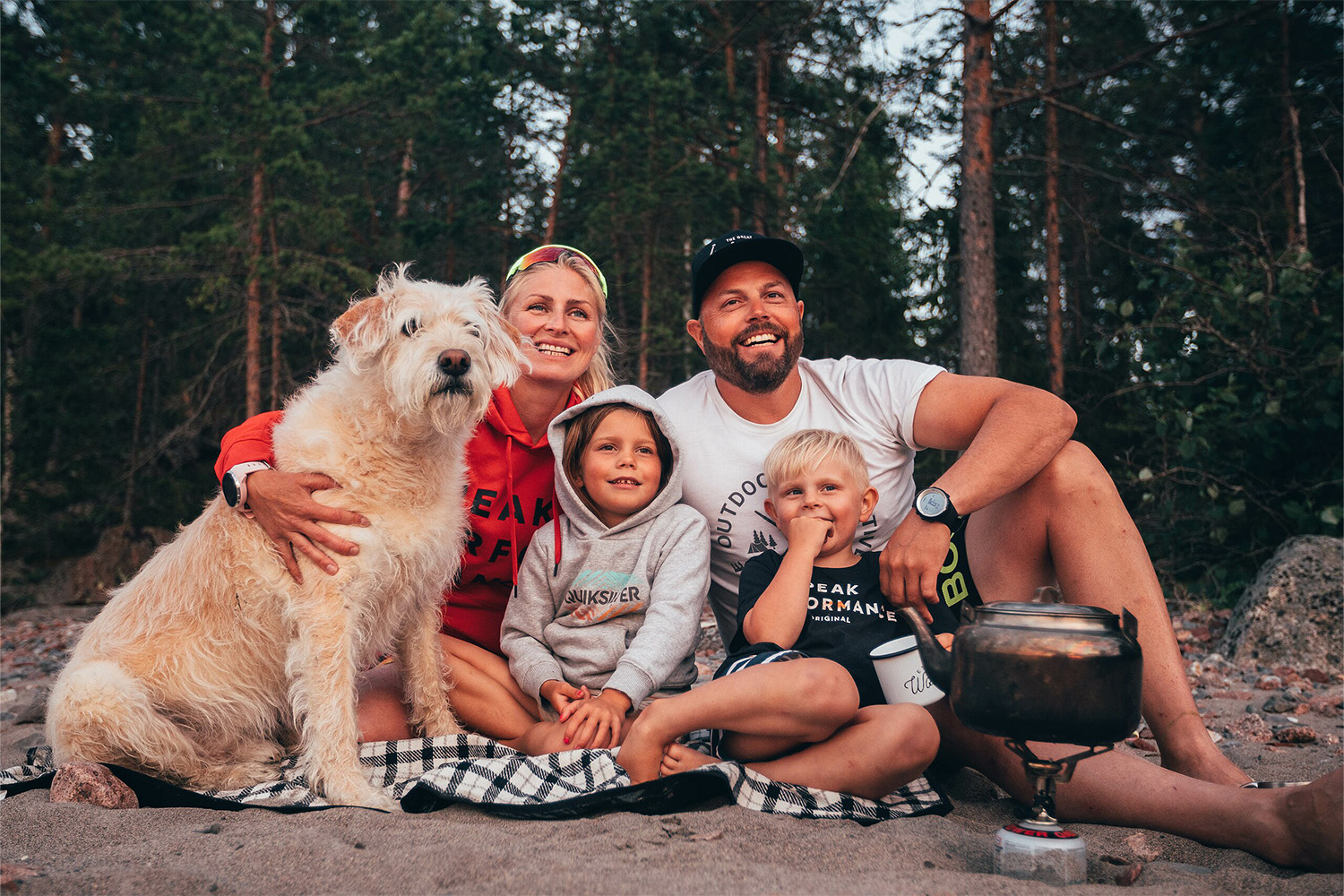
Arthur lived with the Lindnord family for six years, before passing away in December 2020.
Courtesy of Mikael Lindnord
Man’s Best Friend
So we started the long process. First, he needed surgery. Once he was ready medically, a lot of paperwork needed to be filed. That was four days of ups and downs, and originally there were people from the [Board of Agriculture] in Sweden who said no. Don’t forget that I was exhausted through this whole process, because I had been racing for six days straight and then was thrown into this long process of adopting Arthur. In adventure racing, all you can do is give your best for your teammates, and for this second process of getting him to Sweden, I gave him my best as well, because he deserved that.
The part I didn’t foresee was getting the support that we did from the outside world. I wasn’t even aware, but so many people had heard our story about Arthur because the world championship had been posting us on social media. There were people in Sweden who had heard about the story of Arthur and wanted a happy ending for us all.
The last hurdle was some paperwork to travel out of Ecuador. It seemed like that was going to hold us up longer. But at the last moment, the [Social Affairs] minister of Ecuador called me on my phone and asked how they could help, because they had seen our story. We got the last signatures we needed about 20 minutes before we had to check in for our flight. I was so grateful
This incredible group of people and their support had helped us get Arthur to his new home in Sweden, and they made it so that my teammate could be there by my side for many more adventures.
Whether you’re looking to get into shape, or just get out of a funk, The Charge has got you covered. Sign up for our new wellness newsletter today.

